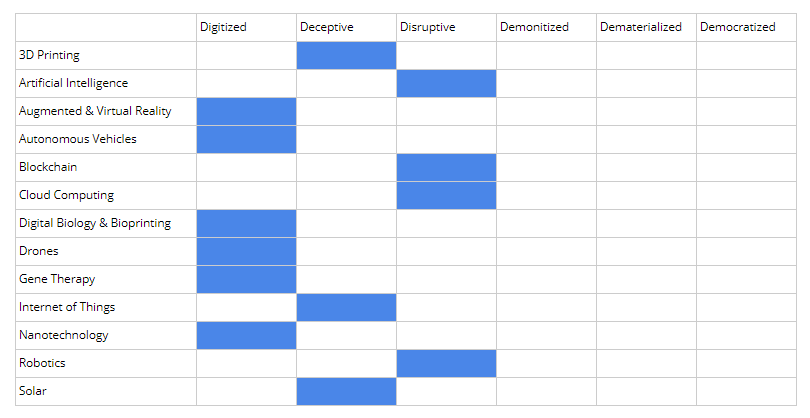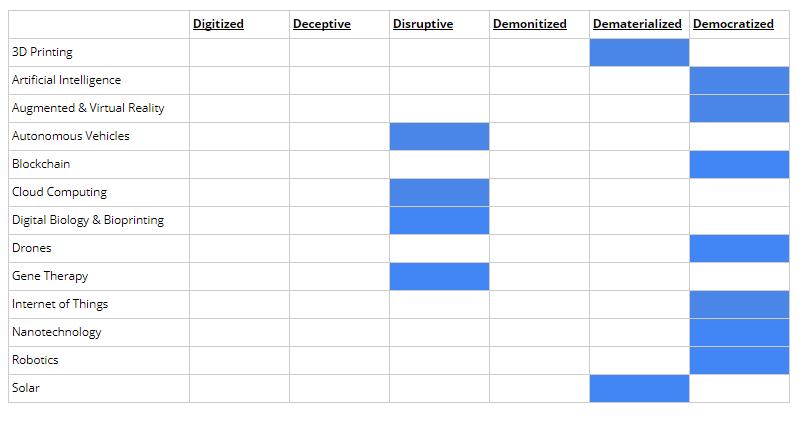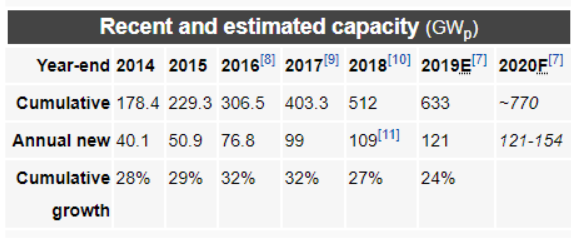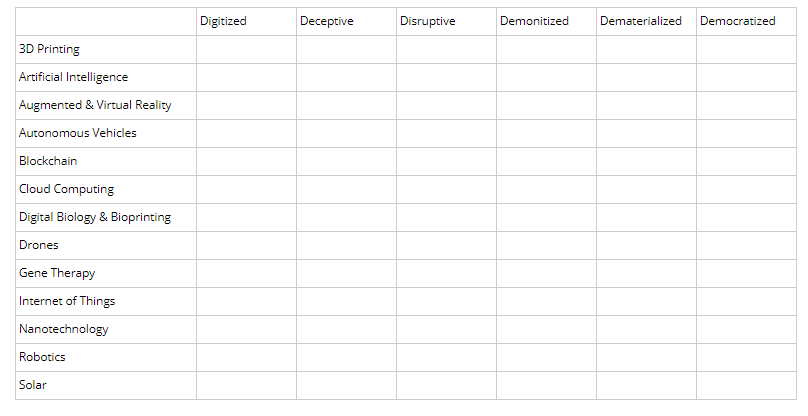Exponential guided innovation for Future-Back Strategies
Using exponential technology predictions as part of a Future-Back strategy will help us aim for a future projected reality.
The world is changing faster than we think. How do we plan a roadmap for our innovation, and reinvention, strategy? Using exponential technology predictions as part of a Future-Back strategy will help us aim for a future projected reality. We would then put the strategy in place for our organization to meet and take advantage of the predicted future.
The world is changing faster than we think. How do we plan a roadmap for our innovation, and reinvention, strategy? Using exponential technology predictions as part of a Future-Back strategy will help us aim for a future projected reality. We would then put the strategy in place for our organization to meet and take advantage of the predicted future.
Index
Why Exponential Innovation?
Future-Back
I have had the privilege of interviewing Mark W. Johnson, author of “Lead from the Future”, on my Business Bookshelf podcast. Mark was also interviewed by Kevin Kruse for an article on Forbes titled “How Musk, Bezos And Other Visionaries Use The “Future-Back” Technique”. In the article, Mark says:
“Bezos and Jobs are outliers, of course, but they both embraced a visionary but learnable mindset that we call “future-back” as opposed to “present-forward.” Present-forward leaders build their organizations in increments, following the rules and procedures that work today. Future-back leaders, in contrast, visualize what their organizations could be, starting from a clean sheet, and then mobilize whatever they need in order to bring it into being. Future-back thinking doesn’t replace present-forward thinking—it complements and completes it.”.
During the Future-Back process the person, or participants, imagine how the world will look at a point in the future. Exponential technology is critical in this process.
Moore’s law
We as humans find it difficult to think in an exponential manner. We like to think that sales projections will continue to increase consistently and grow by x% a year. Exponential thinking is difficult because it starts small, but after the doubling process takes place a few times will grow increasingly large. The most common use of this is Moore’s law.
“Moore’s Law refers to Moore’s perception that the number of transistors on a microchip doubles every two years, though the cost of computers is halved. Moore’s Law states that we can expect the speed and capability of our computers to increase every couple of years, and we will pay less for them. Another tenet of Moore’s Law asserts that this growth is exponential.” – www.investopedia.com
Moore’s law has basically stayed true and the number of transistors incorporated in a chip has doubled roughly every 18 months.
Two conclusions can be drawn from Moore’s law – firstly that it can be applied to almost all exponential technologies and secondly that experts very often get the predictions wrong.
An example – Exponential growth in solar power
An example of this is solar power where in 2016 the International Energy Agency (IEA) projected that, starting that year, the world would add just 50 gigawatts of added solar energy capacity per year and in 2017, the growth of solar would level out and start to decline. But as one clean energy researcher pointed out, the IEA had gotten it wrong about the potential for growth – not just this year, but every year since 2002. Every year, the organization assumed that the growth rate of solar energy would be linear, rather than increasing exponentially as it had largely done for over a decade. As The Guardian reported in March, the amount of new solar power installed worldwide in 2016 increased by about 50 percent, reaching 76 gigawatts. China and the US spearheaded the surge in solar – both countries nearly doubled the amount of PV panels they added in 2015.
Across all exponential technologies
This same doubling process, both in the efficiency and reduction in cost, can be applied across all exponential technologies. Exponential technology categories are: 3D printing, artificial intelligence, augmented and virtual reality, autonomous vehicles, blockchain, cloud computing, digital biology, bioprinting, drones, genetic engineering, internet of things, robotics and solar.
These advances in exponential technology are critical in our Future-Back strategy as we construct how our organizations will look in 5, 10 or even 20 years’ time.
How to map exponential technology?
The process of mapping exponential technology and applying it to a point in time consists of at least a two step process.
Determining the exponential growth
The doubling interval, as described in Moore’s law above, is taking place at different intervals depending on the exponential technology. If you search the internet for any of the exponential technologies listed, you can find this and the current level.
Let us look at solar again as an example. The first solar cells were commercially manufactured in the 1950’s. In 2018 global cumulative installed photovoltaics capacity reached about 512 gigawatts (GW).
To work out the doubling interval of solar, let’s look at the history taken from Wikipedia – Growth of photovoltaics.
-
Source: https://en.wikipedia.org/wiki/Growth_of_photovoltaics
I am not a mathematician or statistician but looking at the spreadsheet above we can see that solar is doubling roughly every three years. Currently, solar in 2019 provides 3% of the world’s power needs. If we use these recent stats to predict the future then in 2022 solar will provide 6% of the world’s power needs, in 2025 it will be 12%, in 2028 the figure will be 24% and taking this forward, by 2034 almost all the world power could be provided by renewable energy.
6D’s of digital disruption
The second step in determining the role of exponential technologies in your organization’s Future-Back strategy is to work out it’s maturity at different times.
Further, read: Disruptive Innovation – Intro, Definition and Meaning of being disruptive
A useful tool to use here is Peter Diamandis’s 6D’s of digital disruption. The 6D’s are: digitization, deception, disruption, demonetization, dematerialization and democratization.
At an extremely high level the two first two D’s – digitization and deception – is when the exponential growth is starting to take place but is at a sufficiently low level that it doesn’t make an impact – even disappoints. The disruption phase is when you start to notice competitors using the technology and it starts to disrupt you. The demonetization, dematerialization and democratization phases are when the technology gets progressively cheaper, smaller and common.
The 6D’s affect the business model, and products/services of course, on which you operate.
The example often used here is photography. Only a few years ago people would buy expensive cameras and carefully take each picture. Today everyone has a powerful camera on their mobile phone and the cost of taking a photo is very close to zero.
This will affect the business models of organizations and people that have anything to do with photography.
To stick with the solar theme. How will the world look in ten years’ time when electricity is basically free? What will happen to the oil, coal and other industries? Will there still be gas/petrol stations?
If you can identify the digital disruption stage of each exponential technology, then you can use this as a guide for your Future-Back strategy.
How to do Exponential Innovation?
Now I must state that this is both fairly straight forward and very difficult. I have been thinking of how to do this for a while and would like to present an option for you to use.
Current state
You could use the table below as a guide.
Using the table below you can start mapping out the maturity of each exponential technology. It is important that you take your industry into account, as financial services will use exponential technology differently to the media industry.
To do this you will need to have done the exercises in the previous section where you know the historical and future growth of each technology.
As an example, here is the completed table based on the financial services industry:

Future state
Of course, the current state is of little importance to your Future-Back strategy.
How will the exponential technologies look in 3, 5, or 10 years time? Here is a guess at how exponential technology will look in 5 years time.

Conclusion on Exponential Innovation
How does this thinking influence your innovation strategy? Is this the way you currently do it? Does the above process make sense to you?
This really is a work in progress. If this has potential to you then I would really value your feedback? Is it worth expanding and working on?



Comments are closed.